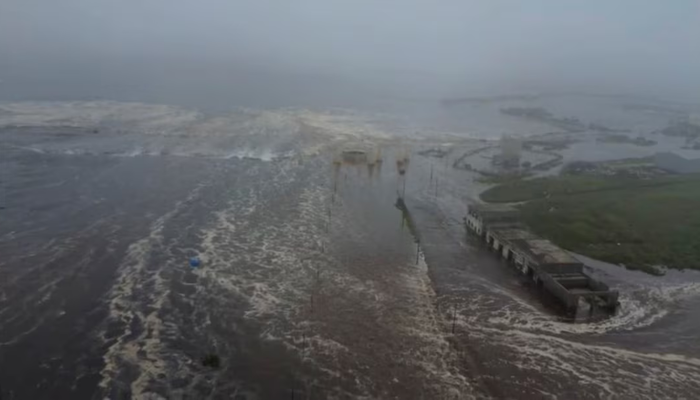A powerful magnitude 8.8 earthquake struck off the eastern coast of Russia early this morning, triggering tsunami warnings across the Pacific. The tremor, one of the strongest ever recorded in the region, originated near Petropavlovsk-Kamchatsky, prompting immediate concern in Japan. The Japan Meteorological Agency swiftly issued tsunami warnings for Hokkaido and the Tohoku region, advising people to move to higher ground.
The tsunami in Japan was part of a larger chain reaction affecting multiple countries and territories bordering the Pacific Ocean. Although the quake’s epicenter lay in Russian waters, the ripples from this seismic shock have traveled thousands of kilometers, demonstrating the immense power behind undersea tectonic movement.
The Japanese government activated emergency protocols, and local officials worked to ensure coastal evacuations were carried out efficiently. Within hours, neighboring regions including Hawaii, California, and French Polynesia began monitoring rising sea levels.
French Polynesia Braces for Massive Waves
While Japan was among the first to issue a tsunami alert, the wave’s impact reached far into the southern Pacific. In French Polynesia, local authorities warned that the Marquesas Islands, particularly Nuku Hiva, could be hit by waves as high as 4 meters (13 feet). The warning extended to Ua Huka and Hiva Oa, where waves between 1.10 to 4 meters were expected to strike overnight.
The High Commission of the French Republic in French Polynesia released an official statement, advising residents to evacuate low-lying coastal areas. Emergency services were mobilized in anticipation of the tsunami’s arrival, with shelters being prepared and boat activity suspended.
Although these island territories lie thousands of kilometers from the earthquake’s epicenter, the tsunami in Japan had set off a domino effect across the Pacific, reaffirming the interconnectedness of tectonic zones.
Pacific Coasts Under Watch from Hawaii to California
On the US mainland and territories, alerts quickly followed. The Pacific Tsunami Warning Center downgraded Hawaii’s status from a warning to an advisory after observing a wave surge of about one meter in Kahului. Residents who had fled to higher ground in places like Ewa Beach were told it was safe to return home, although authorities continued to caution about possible strong currents.
Meanwhile, on the US West Coast, states including Washington, Oregon, and California issued their own tsunami advisories. The National Weather Service recorded rapid water level fluctuations, especially near Monterey Bay in California. In Port San Luis, authorities observed a “rapid and damaging surge,” with tidal shifts happening within minutes.
San Francisco Bay also experienced unusual tidal activity, and the public was warned to avoid beaches, harbors, and marinas. “Do not return to inundated areas,” the NWS advised, adding that multiple waves could follow the initial surge.
Warnings, Watches, and Information Statements Explained
The widespread alerts triggered by the tsunami in Japan highlighted the complexity of international tsunami monitoring. According to the US National Weather Service, there are four main levels of alerts:
-
Tsunami Warning: Signals immediate danger with expectations of flooding or strong currents. Evacuations are usually mandated.
-
Tsunami Advisory: Indicates dangerous wave activity near shorelines. Swimming, boating, and beach activity are discouraged.
-
Tsunami Watch: Issued when a tsunami is possible following a distant earthquake. Authorities prepare to escalate warnings.
-
Tsunami Information Statement: Informs the public that an earthquake has occurred but does not pose a tsunami threat.
Today’s events saw every level of alert in use across the Pacific. Countries and territories adjusted their status in real-time as data from buoys, satellites, and coastal gauges came in.
This rapid coordination between meteorological agencies and governments helped minimize panic and allowed for timely evacuations in high-risk zones.
Read more: Govt Commits Full Support to Bait-ul-Mal’s Healthcare Mission
Global Impact Without Direct Destruction
Though the tsunami in Japan and the earthquake that preceded it did not cause immediate deaths or structural damage, the global reaction underscored the constant threat posed by seismic activity around the Pacific Ring of Fire. More than 60 individuals were evacuated from a beach in Russia’s Kamchatka Peninsula, while alerts reached all the way to Alaska, British Columbia, and the Aleutian Islands.
In Japan, the Meteorological Agency revised the tsunami warnings to advisories for certain prefectures, signaling a reduced threat level. Still, residents were urged to remain cautious as aftershocks and smaller waves could continue for hours.
Islands such as Guam, Saipan, and the Northern Marianas later had their tsunami warnings lifted. Even so, minor sea level changes were noted, reminding authorities of how unpredictable ocean behavior can be following major quakes.
The tsunami in Japan served as a stark reminder of nature’s force and unpredictability. Thanks to swift international coordination, the worst-case scenario was avoided this time. No major loss of life or property has been reported, but the widespread alert system, evacuations, and environmental shifts emphasize the need for continued preparedness.
From French Polynesia to the coastlines of California, the tsunami’s long journey illustrated how one seismic event can ripple across continents, touching millions. While the waves may recede, the lessons about early warning systems, emergency readiness, and cross-border collaboration remain more relevant than ever.
Follow us on Instagram, YouTube, Facebook,, X and TikTok for latest updates
